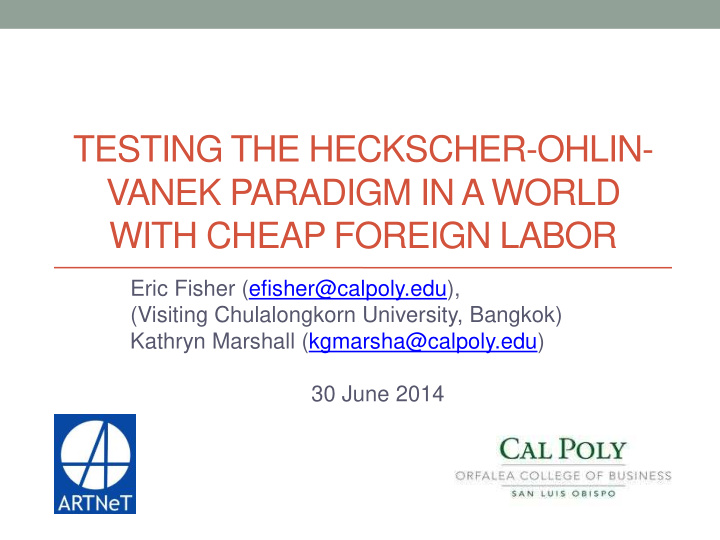



TESTING THE HECKSCHER-OHLIN- VANEK PARADIGM IN A WORLD WITH CHEAP FOREIGN LABOR Eric Fisher (efisher@calpoly.edu), (Visiting Chulalongkorn University, Bangkok) Kathryn Marshall (kgmarsha@calpoly.edu) 30 June 2014
Outline of the talk • Trade in goods is a veil for trade in the factor services. • Empirical tests have not given the theory its due. • Trade in factor services is not trade in physical units. • A hectare of land • The annual rent on a hectare of land • Empirical results • The conventional test predicts the direction of factor trade well • Imposing identical technologies predicts the direction and volume of factor trade well • Adjusting endowments into efficiency units predicts the direction and volume of trade well too.
What I won’t do in this talk • The way we convert factors into international efficiency units is quite novel. • I will not discuss this theory at length, but our empirical test are based upon a strong such foundation. • I won’t deprecate the recent literature, but I will quote Trefler and Zhu (2010) who say that “definitional mistakes are endemic.” • I will not wax philosophical about what HOV theory means when countries do not have the same technologies, but you can egg me on if you might like.
Literature review • Leontief (1953) • Leamer (1984) • Trefler (1995) • Davis and Weinstein (2001) • Fisher and Marshall (2011)
The theory and its predictions • The predicted factor content of trade is: • The measured factor content of trade is: • There are 39 countries and 5 factors, giving 195 predictions. • The technology matrices reduce the dimensionality of trade vectors from 26 to 5.
Why the fixation on physical factors? • Input-output accounting was developed during World War II to predict the employment effects of the demobilization. • Leontief was an intellectual giant, but he analyzed only one country. • What does the theory mean when technologies are different? • If technologies are identical, then the difference between physical factors and local factor services is moot, just a scaling factor. • Only recently have consistent cross-country measures of technology become available.
Simplified factor conversion matrices • Rybczynski effects: • Stolper-Samuelson effects of a change in world prices that is caused by a change in the reference country’s factor prices: • Simplified factor conversion: • Factor content in the reference of the local Rybczynski effects • Its rows show the local Stolper-Samuelson effects of a change in foreign factor prices
Full factor conversion matrices • Technology matrices are not square • The full factor conversion matrix is: • The factor content in the reference of the local Rybczynski effects of smallest magnitude • Its rows give the least squares estimates of the local Stolper-Samuelson effects of arbitrary changes in world prices.
Beautiful property of factor conversion matrices • These matrices map distributions into distributions. • They are linear maps that preserve measures • We will see an illustration of this property in the definition of international efficiency units. • They preserve the duality of Rybczynski effects and Stolper Samuelson effects that are at the heart of applied general equilibrium theory. • Fix prices. An increase in endowments has a supply effects. • Fix quantities. An increase in output prices has factor price effects. • These two effects are identical.
The Tests • The sign test: does the model predict the direction of factor trade correctly? • The null is that it does no better than a coin toss • The alternative is that it’s a tautology • The missing trade regression has measured factor content as the left hand variable and predicted factor content at the right hand variable. It estimates a line. • The null is that the slope is unity and the intercept is zero • An alternative is that the slope is zero and the intercept is zero too.
Three versions • Please recall: always measure the factor content of trade using the reference country’s technology. • The conventional test: No adjustments at all • The benchmark: Every country has identical technology • Factor conversion test: Convert every country’s factors into international efficiency units • Predictions are always on the horizontal axis and measured factor content on the vertical axis.
Missing Trade Regressions
Factor Conversion Test for Land (A) Trade in Land 200 150 100 50 China Germany USA 0 -200 -150 -100 -50 0 50 100 150 200 -50 -100 -150 -200
Factor Conversion Test for Natural Resources (B) Trade in Natural Resources 200 150 100 50 0 Germany -200 -150 -100 -50 0 50 100 150 200 -50 China -100 USA -150 -200
Factor Conversion Test for Labor (E) Trade in Labor 350 250 China 150 Germany 50 -350 -250 -150 -50 50 150 250 350 -50 -150 -250 USA -350
Factor Conversion Matrix for Canada 700 Billions of international dollars 600 500 400 300 200 100 0 Land Natural Capital Labor Social Capital Resources Canada's endowment Canada's endowment in US efficiency units
Factor Conversion Matrix for China 3,500 Billions of international dollars 3,000 2,500 2,000 1,500 1,000 500 0 Land Natural Capital Labor Social Capital Resources China's endowment China's endowment in US efficiency units
Trade Imbalances Matter These data report the local factor content of trade
Conclusions • No one has ever tested the theory properly. • Countries do not have identical technologies • The nihilist will say that the theory is no longer germane • Any economist, after a moment’s reflection, would say that we must recast and test the theory properly, using the values of factor services • Countries indeed export the services of the factors with which they are abundantly endowed. • The only reason for missing trade is that countries have different technologies • There is no significant missing trade after factors are converted into international efficiency units.
Recommend
More recommend